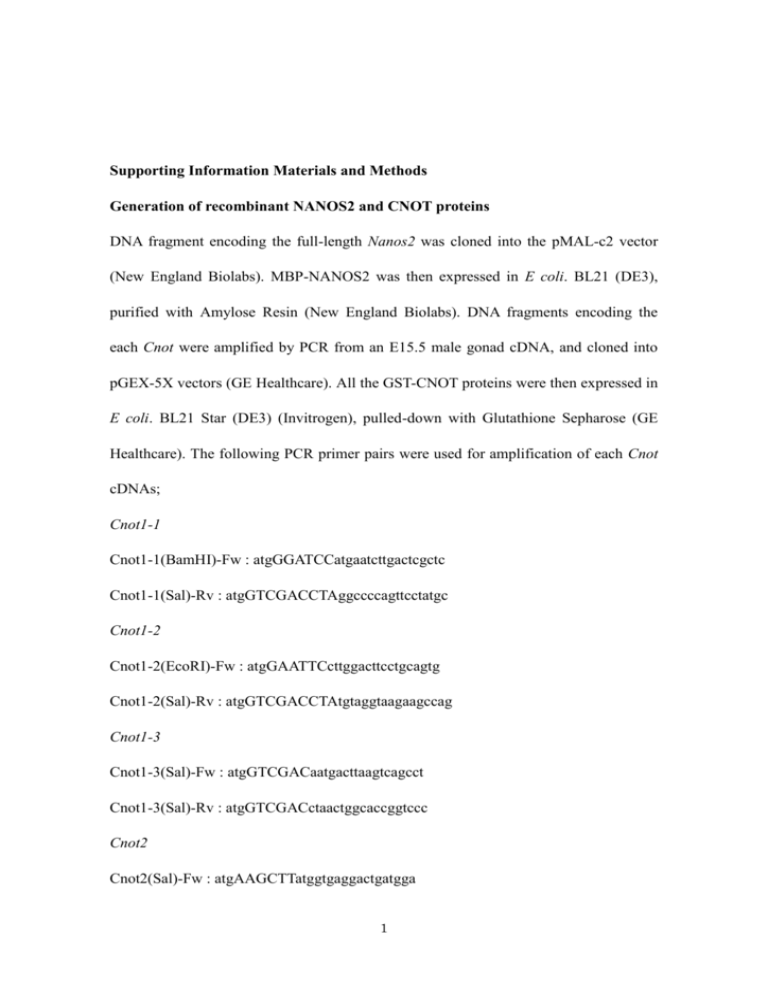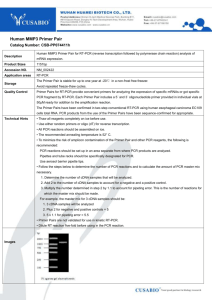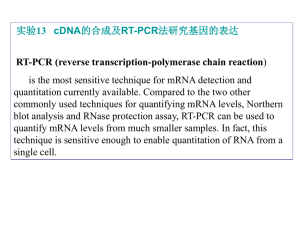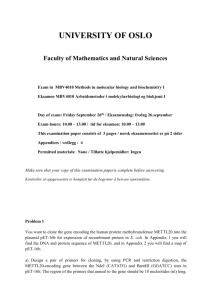Supporting Information Materials and Methods Generation of
advertisement

Supporting Information Materials and Methods Generation of recombinant NANOS2 and CNOT proteins DNA fragment encoding the full-length Nanos2 was cloned into the pMAL-c2 vector (New England Biolabs). MBP-NANOS2 was then expressed in E coli. BL21 (DE3), purified with Amylose Resin (New England Biolabs). DNA fragments encoding the each Cnot were amplified by PCR from an E15.5 male gonad cDNA, and cloned into pGEX-5X vectors (GE Healthcare). All the GST-CNOT proteins were then expressed in E coli. BL21 Star (DE3) (Invitrogen), pulled-down with Glutathione Sepharose (GE Healthcare). The following PCR primer pairs were used for amplification of each Cnot cDNAs; Cnot1-1 Cnot1-1(BamHI)-Fw : atgGGATCCatgaatcttgactcgctc Cnot1-1(Sal)-Rv : atgGTCGACCTAggccccagttcctatgc Cnot1-2 Cnot1-2(EcoRI)-Fw : atgGAATTCcttggacttcctgcagtg Cnot1-2(Sal)-Rv : atgGTCGACCTAtgtaggtaagaagccag Cnot1-3 Cnot1-3(Sal)-Fw : atgGTCGACaatgacttaagtcagcct Cnot1-3(Sal)-Rv : atgGTCGACctaactggcaccggtccc Cnot2 Cnot2(Sal)-Fw : atgAAGCTTatggtgaggactgatgga 1 Cnot2(Xho)-Rv : atgCTCGAGccaagaaaagggaagtcttt Cnot3 Cnot3(Hind)-Fw : atgAAGCTTatggcggacaagcgcaaa Cnot3(Xba)-Rv : atgTCTAGAtgtcactggaggtcccggt Cnot4 Cnot4(Sal)-Fw : atgGTCGACatgtctcgcagtcctgat Cnot4(Xho)-Rv : atgCTCGAGcaattccctctttgcttagt Cnot6 Cnot6(BamHI)-Fw : atgGGATCCatgcccaaagaaaagtac Cnot6(Sal)-Rv : atgGTCGACctacctcctgccaggaag Cnot6l Cnot6l(Sal)-Fw : atgGTCGACatgagactaatagggatg Cnot6l(Sal)-Rv : atgGTCGACctacctccgattaggcaa Cnot7 Cnot7(BamHI)-Fw atgGGATCCatgccagcagcaaccgta Cnot7(Sal)-Rv : atgGTCGACtcatgactgcttgctgg Cnot8 Cnot8(BamHI)-Fw : atgGGATCCatgcctgcggcacttgta Cnot8(Sal)-Rv : atgGTCGACtcactgctgcatgttgtt Cnot9 Cnot9(Hind)-Fw : atgAAGCTTatgcacagcctggcaacg Cnot9(Xho)-Rv : atgCTCGAGtgagagggaacgaggatca 2 Cnot10 Cnot10(Hind)-Fw : atgAAGCTTatggctgcagacaagcctg Cnot10(Xho)-Rv : atgCTCGAGtcacttcctctgcacggt D1Bwg0212e D1Bwg0212e(EcoRI)-Fw : atgGAATTCatgcccggcggcggggcgag D1Bwg0212e(SalI)-Rv : atgGTCGACttattttgatattttggtct Real-time RT-PCR Total RNA isolates were prepared from the E14.5 male gonads of wild-type, full-length and Nanos2-ΔN10 transgenic mice using an RNeasy Mini Kit (Qiagen). Aliquots of 0.5 µg of total RNA were then used in a cDNA synthesis reaction with SuperScript III reverse transcriptase (Invitrogen). For real-time RT-PCR, amplification reactions were carried out in 96-well microtiter plate wells in a 25 μl reaction final volume with SYBR premix Ex Taq (Takara), optimized concentrations of specific primers, and a 1:20 dilution of each cDNA as the template. Reactions were carried out using a Dice Real Time PCR Detection System (Takara) and the cycling conditions involved an initial step of 10 s at 94°C, followed by 40 cycles of 15 s at 94°C, 15 s at 60°C, 30 s at 72°C. Each assay was run in triplicate and negative controls (no template or template produced without the RT enzyme) were always included. The data were processed using Thermal Cycler Dice RealTime System Software (Takara) and Microsoft Excel. A normalization factor was calculated using the reference gene G3PDH. The following PCR primer pairs were used for the amplification of total 3 Nanos2 mRNA: Nanos2-Fw for RT-PCR: attcagagccggaagcaaag, Nanos2-Rv for RT-PCR: gactgctgttgagtggacaa. For semi-quantitative RT-PCR, PCR reactions were carried out in 8-well microtiter tubes in a 20 μl reaction volume with Takara-Taq (Takara) with optimized concentrations of specific primers and a 1:20 dilution of each cDNA as template. Products were separated in 11% polyacrylamide gels stained with ethidium bromide and were visualized using a Bio Doc-ItTM system (UVP). 4








